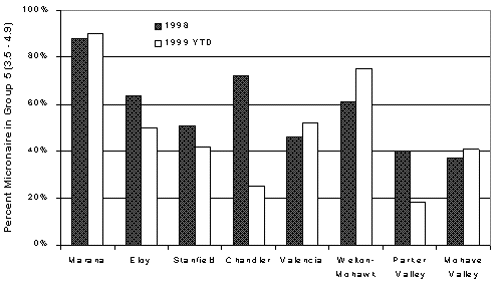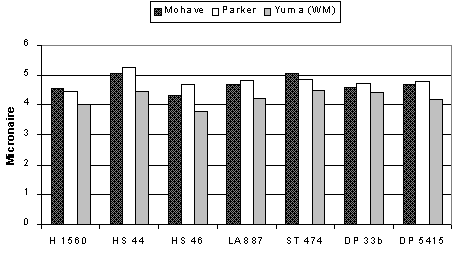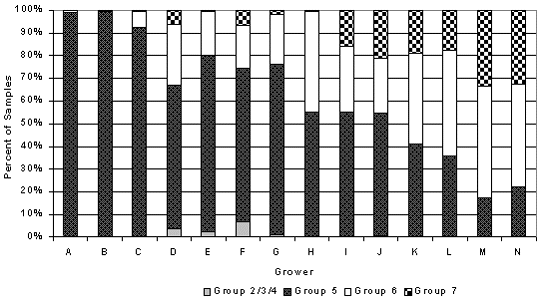Environmental and Management Impacts on Micronaire in Arizona
by Jeffrey C. Silvertooth,
Extension Agronomist - Cotton
When considering the micronaire characteristics of cotton fiber we commonly regard the following three basic components as being very important: 1) genetics, 2) environment, and 3) management. One very good source of information to assess the genetic or varietal influence on cotton micronaire is the data generated by the statewide variety testing program conducted by the University of Arizona (UA). This program is directed by Dr. Hal Moser (UA) in cooperation with county agents, seed company representatives, and farmer-cooperators in many locations across the state. Another good source of information of this type includes the data provided by commercial seed companies from their variety testing programs in Arizona. Micronaire in these tests will vary widely at different locations. But varieties may have a tendency to produce higher micronaire across locations in a consistent pattern with one another. From some recent analysis of this type of data in central Arizona, Dr. Moser has indicated that only about 20% of the variation in these tests for a particular year was due to genetics (or the variety). Thus, we should try to determine the manner and extent that environment and management serve to influence fiber micronaire.
The data in Figure 1 describe the percentage of the crop classed with Group 5 micronaire (3.5-4.9, below the discount range) in 1998 and 1999 for eight areas in Arizona. From these data we can see that high micronaire is less of a problem at higher elevations (> 2,000 ft.), as seen from the Marana. Generally, as you move into lower elevations (e.g. Lower Colorado River Valley), the tendency for higher micronaire increases. However, an important exception to this trend is the data for Wellton-Mohawk (Yuma County). Based on elevation and environmental considerations (e.g. high night temperatures), the Yuma area should be considered a high micronaire environment. However, as shown in Figure 1 Yuma actually has a higher percentage of Group 5 micronaire than many central Arizona locations. When a similar set of varieties are considered among three locations in the Lower Colorado River Valley (Figure 2), we see that the Parker and Mohave Valleys tend to produce higher micronaire values than the Yuma area. These observations support the conclusion that there is a significant contribution from management in the formation of fiber micronaire. One important factor to consider in contrasting Yuma with other areas in Arizona is the dominance of the vegetable industry and the impacts on cotton crop management. Cotton fields are commonly planted earlier and also terminated and defoliated quite aggressively in an effort to accommodate the planting of vegetable crops in the fall.
The fact that crop management can have a significant impact on fiber micronaire is further illustrated in Figure 3 which shows the percentage of the crop classed with various micronaire groupings among certain growers (Growers A – N on the x – axis) in the same central Arizona area. The lighter, upper portions of the bars represent the discount ranges of micronaire (> 5.0). Some growers clearly do not have a high micronaire problem while others using the same general set of varieties do. The data are not shown, but it is important to add that the growers with a minimal amount of high micronaire cotton also have very good yields.
Thus, management is a very important factor in determining fiber micronaire. The good news is that if we can determine what management factors are important in this process, we have the potential of improving the overall micronaire characteristics of the Arizona cotton crop.

Figure 1. Percentage of the Arizona crop by selected locations in 1998 and 1999 classed in micronaire groupings.

Figure 2. Micronaire trends for several varieties in three Lower Colorado
River Valley locations, 1999.
 Figure 3. Distribution of micronaire values among several growers in a
central Arizona area, 1999.
Figure 3. Distribution of micronaire values among several growers in a
central Arizona area, 1999.
[NOTE: Data used in Figures 1-3 courtesy of the
Anderson-Clayton Company.]
Issued in furtherance of Cooperative Extension work, acts of May 8 and June 30, 1914, in cooperation with the U.S. Department of Agriculture, James A. Christenson, Director Cooperative Extension, College of Agriculture and Life Sciences, The University of Arizona.
The University of Arizona is an equal opportunity, affirmative action institution. The University does not discriminate on the basis of race, color, religion, sex, national origin, age, disability, veteran status, or sexual orientation in its programs and activities.
Any products, services, or organizations that are
mentioned, shown, or indirectly implied in this web document do not imply
endorsement by The University of Arizona.
Information provided by Jeffrey C. Silvertooth, silver@ag.arizona.edu
Extension Agronomist - Cotton, College of Agriculture, The University of Arizona.
Material written 25 March 2000.
Home | Cotton | Advisories
document located at: http://cals.arizona.edu/crops/cotton/comments/mar2000cc.html
Copyright © 2001 University of Arizona,
College of Agriculture and Life Sciences
Webmaster: Al Fournier (acis@ag.arizona.edu)